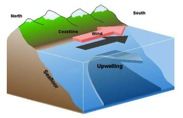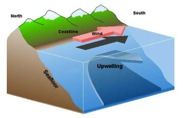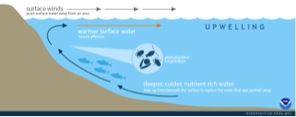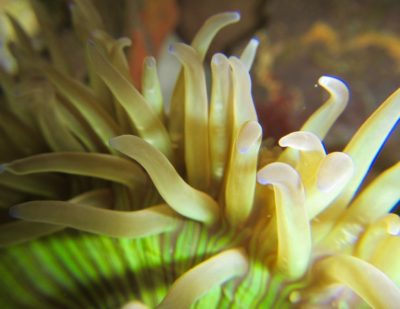
It’s a universal understanding amongst all fishermen (and women!) that there are good fishing days, and most definitely bad fishing days. Sometimes all it takes is being in the right place at the right time or maybe even sporting some good ocean karma. There is, although, some technicality and logic behind it all to ensure the most optimum of catching days. It may be hitting up the right location, using the right bait, or stalking bait-balls offshore all afternoon. But what initially attracts the fish to congregate in these places? The obvious answer is food, which could be from a variety of sources. One of those sources is upwelling.
 Upwelling occurs all throughout the globe and in different natures. Essentially what happens is surface water along coastal shores is being pushed offshore by the influence of steady winds. As this happens, the pushed out surface water is being replaced by bottom water that is being drawn up through a current. This bottom water is cold and high in nutritious goodies. We see this exactly at the equator where trade winds blow from east to west drawing water away from South America and towards Indonesia. Prime fishing spots are located just off the coast of Ecuador and Peru.
Upwelling occurs all throughout the globe and in different natures. Essentially what happens is surface water along coastal shores is being pushed offshore by the influence of steady winds. As this happens, the pushed out surface water is being replaced by bottom water that is being drawn up through a current. This bottom water is cold and high in nutritious goodies. We see this exactly at the equator where trade winds blow from east to west drawing water away from South America and towards Indonesia. Prime fishing spots are located just off the coast of Ecuador and Peru.  Alternatively along the California coastline, winds blow southward from Alaska towards Baja. Here, coastal waters, with the influence of the earth’s rotation, are instead pushed out 90 degrees from the direction of the wind and travel out into the Pacific. We call this process Ekman Transport where our rotating earth creates a force that drags the wind-induced currents to the right in the northern hemisphere. This is reversed in the southern hemisphere where it would travel to the left of the wind. We don’t see this happen at the equator, although, because the earth is wider and spins faster there. Ultimately, the same result occurs where water is transported away from the coast and cold, nutrient-rich waters from the bottom are moved to the surface.
Alternatively along the California coastline, winds blow southward from Alaska towards Baja. Here, coastal waters, with the influence of the earth’s rotation, are instead pushed out 90 degrees from the direction of the wind and travel out into the Pacific. We call this process Ekman Transport where our rotating earth creates a force that drags the wind-induced currents to the right in the northern hemisphere. This is reversed in the southern hemisphere where it would travel to the left of the wind. We don’t see this happen at the equator, although, because the earth is wider and spins faster there. Ultimately, the same result occurs where water is transported away from the coast and cold, nutrient-rich waters from the bottom are moved to the surface.
This transport of nutritious bottom water along the California Coast promotes prime fishing, especially for local fisheries in our area. The next time you go fishing and can’t find that trusty bait ball of yours, stick close to the shore. Also keep in mind how this natural process might change this upcoming year with El Niño. Typically, strong dissipation in coastal upwelling is observed more south around the equator during this type of event, but we may see some changes along the Southern California coast.
Written By: John Cornett
Photo Credits:
Coastal Upwelling – https://www.climate.gov/news-features/features/upwelling-crisis-ocean-acidification
Nutrient Upwelling – http://oceanservice.noaa.gov/facts/upwelling.html


